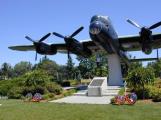1
The new Operation Manna Logo2007
Windsor, Ontario
 Credits:
Credits:Lorraine Cantin
Michael Kohuch
James Klingbile
Pauline Stanton
2
A design was needed to capture in a simple visually appealing way the spirit of this sortie. Symbols that represented the mission and the countries involved needed to be carefully chosen so that they could be related to the story. The tulip is an internationally recognized symbol of the Netherlands, and the Maple Leaf is an equally recognized symbol of Canada. When blended together the design is representative of the closeness of the two countries.This beautiful Logo was featured in further book talks, speeches to veteran and civic groups and taken whenever there was an opportunity to tell this story. It was placed on post cards and handed out at Canadian Historical Aircraft Association events. It was painstakinly hand carved into our Museum flooring, where it has maximum exposure. It is for us a symbol of pride for our Windsor men, and the others who flew that mission. It reminds us on a daily basis, that we need to keep remembering what our veterans have done in the name of Canada. The Year of the Veteran was celebrated in 2005, but we feel that this Logo will keep it current for us. Here we celebrate it every year.
4
Author Glen Mitchell had written a book about Operation Manna, " A Bad Penny Always Comes Back". He was engaged in a number of public readings, in particular those at schools. The Canadian Historical Aircraft Association members felt that a permanent tribute would honor these men and a logo was designed to show the special bond that still exists between the Netherlands and Canada. One half of the Maple Leaf is missing to signify what we gave to the Netherlands and the tulips complete the logo. Once the logo was ready , Glen was asked to take the blank logo design with him and have the children color them for us. Some of them were absolutely wonderful, but it was impossible to choose one, so we compromised. We chose the colors used most often.6
Red was chosen for red symbolizes passion. The young men and women who served in the war believed in the job set out for them. Holland sent tulips to Ottawa after the war. We believe that this gift represented the feelings of the Dutch people for the Canadians. In this way they could show the World their love for these people who had given the ultimate gift- their lives.7
Yellow tulips below the Lancaster bomber at Jackson Park in WindsorJune 2003
Windsor, Ontario
 Credits:
Credits:George Mock
8
Yellow tulips were also sent to Ottawa. This colour symbolizes hope. Those Dutch who looked up into the Spring skywhen they heard the plane, saw sunshine, and from that sky emerged a plane that dropped food. The yellow tulips emerge from the cold, Canadian ground every Spring, and become sunshine on a stalk. They suggest that there is always hope, but sometimes it takes a long time for it to be realized. The Dutch waited through two long winters before it became a reality.9
Pink roses at Jackson Park in Windsor, OntarioJune 2000
Windsor, Ontario
 Credits:
Credits:George Mock
James Klingbile
10
The pink tulips suggest blood mixed with tears. All of those lives lost, all of those families ripped apart. When the flowers fade, and petals drop to the ground tear drops or drops of blood, we relize that life does go on. The flower is gone but in the Spring life will sprout up once again- a rebirth but not of those lost- for them it is a remembrance.11
Purple wreath ribbons at Jackson ParkFall 2000
Windsor, Ontario
 Credits:
Credits:George Mock
James Klingbile

